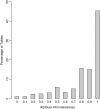Structured Open Urban Data: Understanding the Landscape
- PMID: 25276498
- PMCID: PMC4174913
- DOI: 10.1089/big.2014.0020
Structured Open Urban Data: Understanding the Landscape
Abstract
A growing number of cities are now making urban data freely available to the public. Besides promoting transparency, these data can have a transformative effect in social science research as well as in how citizens participate in governance. These initiatives, however, are fairly recent and the landscape of open urban data is not well known. In this study, we try to shed some light on this through a detailed study of over 9,000 open data sets from 20 cities in North America. We start by presenting general statistics about the content, size, nature, and popularity of the different data sets, and then examine in more detail structured data sets that contain tabular data. Since a key benefit of having a large number of data sets available is the ability to fuse information, we investigate opportunities for data integration. We also study data quality issues and time-related aspects, namely, recency and change frequency. Our findings are encouraging in that most of the data are structured and published in standard formats that are easy to parse; there is ample opportunity to integrate different data sets; and the volume of data is increasing steadily. But they also uncovered a number of challenges that need to be addressed to enable these data to be fully leveraged. We discuss both our findings and issues involved in using open urban data.
Figures
















References
-
- The World Bank. Urban Development. Available online at http://data.worldbank.org/topic/urban-development, 2014. (Last accessed on Feb. 2, 2014)
-
- Goldstein B, Dyson L. Beyond Transparency: Open Data and the Future of Civic Innovation. San Francisco: Code for America Press, 2013
-
- Höchtl J, Reichstädter P. Linked open data—a means for public sector information management. In: Electronic Government and the Information Systems Perspective, Volume 6866 of Lecture Notes in Computer Science. Berlin: Springer, 2011, pp. 330–343
-
- Shadbolt N, O'Hara K, Berners-Lee T, et al. . Linked open government data: Lessons from data.gov.uk IEEE Intell Syst 2012; 27:16–24
-
- NYC Open Data. Available online at http://data.ny.gov (Last accessed on September3, 2014)
Publication types
LinkOut - more resources
Full Text Sources
Other Literature Sources
